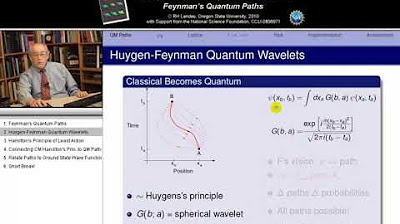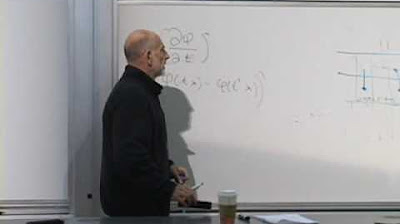Explaining the Principle of Least Action: Physics Mini Lesson
TLDRIn this physics mini-lesson, the profound Principle of Least Action is introduced, a concept that has shaped our understanding of physics from Newtonian mechanics to quantum field theory. The principle suggests that particles follow the path with minimized action, which is a number assigned to each possible trajectory. The video explains how this principle leads to Newton's laws and touches on its relevance in quantum mechanics and beyond, offering a deeper insight into the fundamental workings of the physical world.
Takeaways
- 🌟 The Principle of Least Action is a fundamental concept in physics that has applications across various fields, including Newtonian mechanics, relativity, quantum mechanics, and quantum field theory.
- 🔍 The principle suggests that a particle traveling from point A to point B will follow the path for which the action is minimized, where 'action' is a quantity associated with each possible path.
- 📈 The concept was developed in the 17th and 18th centuries by Lagrange, Hamilton, and others, as an alternative to Newton's approach to determining a particle's trajectory.
- 🌐 In quantum mechanics, Feynman showed that a particle traverses all possible paths between two points, with the path of least action being the most probable or dominant one.
- 📚 The video aims to explain the Principle of Least Action and demonstrate how it can reproduce the equations for Newton's laws, assuming basic knowledge of force, potential energy, and calculus.
- 🎯 The Lagrangian (L) is introduced as a function that combines kinetic and potential energy, and is used to define the action as the integral of L along the particle's trajectory.
- 📊 The Euler-Lagrange equations are derived from the action principle, providing a systematic way to find the equations of motion for a system by minimizing the action.
- 🔄 The principle of least action is not only a powerful tool in classical physics but also has roots in quantum mechanics, where it emerges from the path integral formulation.
- 🌈 The video series promises to explore the action principle in various contexts, including special relativity, general relativity, and string theory.
- 💡 The Feynman path integral is a key quantum mechanical concept that assigns a phase to each path, with the path of least action having the most significant contribution to the transition amplitude.
- 🚀 The principle of least action reveals a deep connection between quantum mechanics and classical physics, where the classical path is the one that minimizes the action.
Q & A
What is the Principle of Least Action in physics?
-The Principle of Least Action is a fundamental concept in physics that states that the path taken by a particle between two points is the one that minimizes the action. The action is a quantity that is assigned to each possible path and is calculated by integrating the Lagrangian along the trajectory.
Who were the scientists that proposed the Principle of Least Action?
-The Principle of Least Action was developed by scientists such as Lagrange and Hamilton in the 17th and 18th centuries as an alternative to Newton's approach to understanding the paths of particles.
How does the Principle of Least Action relate to Newton's laws of motion?
-The Principle of Least Action can be used to derive Newton's laws of motion. By minimizing the action, which is the integral of the Lagrangian along a path, one arrives at the equations of motion that are consistent with Newton's second law, F = ma.
What is the Lagrangian in the context of the Principle of Least Action?
-The Lagrangian, denoted as L, is a function that is used in the Principle of Least Action. It is defined as the difference between the kinetic energy and the potential energy of a system, or L = (1/2)m * (ẋ)^2 - U(x), where m is the mass, ẋ is the velocity, and U(x) is the potential energy.
How does the Euler-Lagrange equation emerge from the Principle of Least Action?
-The Euler-Lagrange equations emerge as the necessary conditions for the action to be minimized. These equations are derived by varying the action with respect to the coordinates and their time derivatives, leading to the equations of motion for the system.
What is the significance of the action being minimized in the context of quantum mechanics?
-In quantum mechanics, the principle of least action is realized through the path integral formulation. The particle considers all possible paths between two points, each weighted by an exponential of the action divided by Planck's constant. The path that minimizes the action dominates the probability amplitude, leading to the classical trajectory in the limit of large quantum numbers.
How does the concept of a geodesic relate to the Principle of Least Action in general relativity?
-In general relativity, the Principle of Least Action leads to the concept of a geodesic, which is the shortest path between two points in a curved spacetime. The action is minimized when a particle follows a geodesic, which is the generalization of a straight line in curved spacetime.
What is the role of the Lagrangian in deriving the equations of motion?
-The Lagrangian is crucial in deriving the equations of motion using the Principle of Least Action. By minimizing the action, which is the integral of the Lagrangian over time, one can obtain the Euler-Lagrange equations, which provide the equations of motion for the system.
How does the Principle of Least Action apply to systems with multiple particles?
-The Principle of Least Action applies to systems with multiple particles by considering the action as the integral of the Lagrangian over time for all particles. The equations of motion for each particle are then obtained by applying the variational principle to the total Lagrangian of the system.
What is the relationship between the action and the transition amplitude in quantum mechanics?
-In quantum mechanics, the transition amplitude, which determines the probability of a particle moving from one point to another, is related to the action through a path integral. Each possible path from the initial to the final point is weighted by an exponential of the action divided by Planck's constant, and the sum of these weights gives the transition amplitude.
How does the Principle of Least Action connect to string theory?
-The Principle of Least Action plays a foundational role in string theory, where the action principle is applied to a relativistic string. The equations of motion derived from minimizing the action for a string lead to the dynamics described by string theory.
Outlines
🌟 Introduction to the Principle of Least Action
This paragraph introduces the viewer to the principle of least action, a fundamental concept in physics that has been instrumental in shaping our understanding of the world for centuries. The speaker, Elliot, explains that this principle offers an alternative perspective to traditional physics, underpinning various theories from Newtonian mechanics to quantum field theory. The concept is illustrated with the example of a particle traveling between two points, where the path chosen is the one that minimizes the 'action'—a quantity assigned to each possible path. Elliot also mentions that this principle is not only applicable to classical physics but also has a role in quantum mechanics, as demonstrated by Feynman's path integral formulation.
📚 Deriving the Equation of Motion Using Least Action
In this paragraph, Elliot delves into the mathematical derivation of the equation of motion using the principle of least action. He begins by discussing the action as a number assigned to each possible path of a particle and how the actual path taken is the one that minimizes this action. The explanation includes a review of basic calculus and Newton's second law (F=ma), and introduces the concept of potential energy. Elliot then introduces the Lagrangian, a function that combines kinetic and potential energy, and explains how the action is defined as the integral of the Lagrangian along the trajectory. The goal is to find the path that minimizes this action, leading to the derivation of the equations of motion that are consistent with Newton's laws.
🔍 Variational Calculus and the Critical Path
This section focuses on the variational calculus involved in determining the critical path—the path that minimizes the action. Elliot explains the concept of extremal points in calculus, where the slope of a function vanishes, and applies this to the action. He describes how small variations in the path (denoted as epsilon) are considered and how the change in the action is analyzed. Through integration by parts and the application of Taylor series, Elliot shows that the change in the action is zero for the path that satisfies the equation of motion, thus confirming that this path minimizes the action. This process leads to the Euler-Lagrange equations, which provide a general method for finding the equations of motion for a system.
🌌 Quantum Mechanics and the Least Action Principle
In the final paragraph, Elliot connects the principle of least action to quantum mechanics. He explains Feynman's path integral formulation, where a particle is considered to take all possible paths between two points, each assigned a weight based on the action of the path. The path integral, which sums these weights, is dominated by the path that minimizes the action, leading to the classical solution. This connection between quantum mechanics and the principle of least action is a profound demonstration of the latter's significance in physics. Elliot also mentions that the principle extends beyond the non-relativistic particle to include special and general relativity, as well as string theory, hinting at future videos that will explore these topics.
Mindmap
Keywords
💡Principle of Least Action
💡Lagrangian
💡Action
💡Euler-Lagrange Equations
💡Newtonian Mechanics
💡Quantum Mechanics
💡Path Integral
💡Feynman
💡Special Relativity
💡General Relativity
💡String Theory
Highlights
Introduction to the principle of least action as a foundational concept in physics.
Explanation of how the principle of least action underlies Newtonian mechanics, relativity, quantum mechanics, and quantum field theory.
Discussion on how the principle differs from Newton's approach, offering a unique perspective on physics.
Introduction of Lagrange and Hamilton's contributions to the principle of least action in the 17th and 18th centuries.
Feynman's quantum mechanics interpretation of particles traversing all possible paths.
The principle's applicability from Newtonian mechanics to string theory explained.
Description of how to apply the principle of least action to find the trajectory of a particle.
Illustration of how the principle leads to the equations of motion known from Newton's laws.
Clarification on prerequisites needed to understand the principle of least action, including basic calculus.
Introduction to the Lagrangian and its significance in the principle of least action.
Explanation of how the action is calculated and its role in determining a particle's trajectory.
Detailed walkthrough of the calculus used to derive the equations of motion from the principle of least action.
The Euler-Lagrange equations introduced as a way to find extremal points in the action's path.
How the principle of least action connects to quantum mechanics through Feynman's path integral formulation.
Future videos promised to explore the principle of least action in relativity, general relativity, and string theory.
Transcripts
Browse More Related Video

How Feynman did quantum mechanics (and you should too)

Lecture 7 | String Theory and M-Theory

Lagrangian and Hamiltonian Mechanics in Under 20 Minutes: Physics Mini Lesson

Is ACTION The Most Fundamental Property in Physics?

17.7 Feynman Quantum Path Integrals I

Lecture 10 | New Revolutions in Particle Physics: Basic Concepts
5.0 / 5 (0 votes)
Thanks for rating: